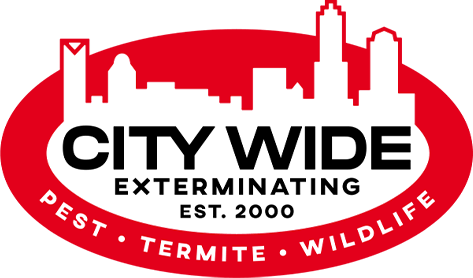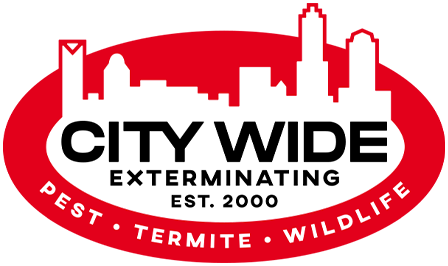Charlotte is home to many nuisance wildlife species. We can find these creatures in both urban and rural parts of Queen City and surrounding areas. With colder weather quickly approaching, we want to address the top 5 problem wildlife that we deal with at City Wide Exterminating on a daily basis. While not all-encompassing, these problems are some of the most common wildlife removal and exclusion calls we get.
1. House Mouse: Mice are small rodents that can invade a home through openings as small as 3/8 of an inch (or for the visual people: the size of a dime!). It is reported that they invade nearly 21 million homes in the United States each winter with their biggest visiting months being October through February. Mice typically wander inside while seeking shelter, food, and water during these cold winter months.
Why is it so important to make sure my home is rodent-proof? These mice can carry diseases like Hantavirus and Salmonella and have the potential to carry 200 human pathogens. They produce anywhere from 40 to 100 droppings per day and continually drop small amounts of urine as they travel through homes. A single mouse can also turn into many mice in just a few weeks as a female is able to have up to 12 babies every 3 weeks!
2. Snakes: While all snakes are not harmful, many people do not want to deal with them in their homes. Oftentimes, snakes are tempted to enter homes either looking for cool, damp, dark places or lured by the smell of smaller pests such as mice. Snakes can enter a home through very small openings or even just a gap under an entry door.
How do I keep snakes from entering my home? Trimming vegetation in the yard near the house is a good place to start. Reducing the livable areas next to the home may be enough to discourage them from setting up shop next to the home. Many people also believe that if you get rid of the food source (mice) in a home, then the snakes will just leave. This may be partially true in some instances, but if you decide to properly rodent-proof a home while snakes are still present inside, you run the risk of trapping the snake in the home. If this is an option you’re considering, we strongly recommend that you consult a company with a professional wildlife agent on staff prior to beginning.
3. Gray Squirrels: The Gray Squirrel is a ravenous chewer and can easily find an exposed edge, construction gap, or weak area of a home. Many times these areas are out of sight from the ground, and can only be found with a thorough ladder inspection. Ranging from 16-18″ from nose to tail, if they find even just a tiny opening, they chew a larger hole in order to gain better access. Squirrels then begin to bring in material to build their nests. The winter months are one of two peak breeding times for squirrels, so we typically see an uptick in squirrel calls in the Charlotte area.
What is the best way to keep squirrels out of my home? Exclusion is always best. Exclusion consists of identifying problem areas or weaker spots and using professional materials to permanently and properly seal those areas. If you already have squirrels living in your home, please consult a wildlife professional before beginning any exclusion or removal. Depending on the time of year, you may inadvertently seal mama squirrel out while her baby squirrels are left inside the nest. And like many mothers, she will do whatever it takes to get back to her babies – including chewing open that gap you thought you just fixed!
4. Bats: Bats are very unique creatures in that they are the only mammal capable of truly flying, unlike a few other species that may glide short distances. Bats feed on insects, including mosquitoes, but I wouldn’t count on them alone for mosquito control.
But I thought bats were good to have around? Bats are beneficial to the environment as a whole, but their droppings (also known as guano) and urine building up in your home, are a biohazard and can create an unhealthy mess. Once bats are evicted, bat proofing a home involves sealing every gap in the home greater than about 3/8 of an inch. Finding these gaps is the true challenge and consulting a wildlife specialist with a familiar knowledge of construction is the best option for long-term results.
5. Norway Rat: We’ve heard Norway Rats referred to in the Charlotte area as “the size of small dogs.” That may be quite a stretch, but they are considerably larger than a typical house mouse. They are opportunistic and will more likely thrive in urbanized areas where food sources are more abundant. They prefer fresh foods such as grains, fish, nuts, and some fruit. Known as strong burrowers, rat-proofing a home poses some challenges, but it can be done by an experienced wildlife professional.
How can I tell if I have a rat (and not mice) problem? When comparing adults, rats are considerably larger than mice. They range from 9-11″ long with a 7-9″ tail! They can also weigh nearly 10 times the amount that a house mouse weighs. Rat droppings are also significantly larger and more noticeable than that of a mouse.
If you live in Charlotte or the surrounding area and need wildlife removal to solve a nuisance wildlife problem in your home, call City Wide Exterminating at (704) 850-6091 or contact us on the sidebar at CityWideExterm.com.

